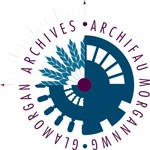Identifying articles donated or loaned to Glamorgan Archives is generally straightforward, particularly when the donor is able to provide the relevant detail. However, occasionally we have to use networks and contacts to “join the dots” in compiling a comprehensive description of new items added to the collection.

A recent example of such networking arose when two photographs of St James’ Cricket Club were added to the collection. Both were formal team photographs taken in 1908 and 1910. So far so good, but the donor was unable to provide further details. However, with information drawn from Cathays Heritage Library and with help from the Museum of Welsh Cricket we have been able to draw together background detail on the photographs.

In short, the site occupied by the church was donated by Lord Tredegar in 1877 with the aim of replacing the mission church established in the Tredegarville school. The first church on the site, known as St James the Great, was made from corrugated iron and opened in 1878. This temporary accommodation was replaced in 1894 by the stone building that can still be seen today, on the corner of Newport Road and Glossop Road, built in the early English gothic style.
It is likely that the cricket team dates back to the opening of the first church. Certainly from 1881 onwards there are reports of games played by the church team, initially known as St James’ Choir Cricket Club but later simply as St James’ Cricket Club. By the 1890 the St James’ Cricket Club was an established side, competing with junior sides across Cardiff each year for the Cardiff District Cricket Union Challenge Cup. The club was also a founder member of the Cardiff and District Cricket League established in 1895, and league champions in 1898.
The teams in the 1908 and 1910 photographs are quite a seasoned group. The senior players include George Wozencroft, Bill Wilks, Fred Mees, Gomer Roberts and Fred Wood. George Wozencroft, a joiner by trade, was well known in cricket circles having played for a number of local sides. In his younger days George had been one of the best bowlers in the district, and he was also a talented batsman who had played for a Glamorgan Colts side against the county side. The bowling attack was led throughout this period by Bill Wilks, who worked at the Ely Colliery, and Gomer Roberts, a clerk on the Taff Vale Railway. They were well supported by the “two Freds” Mees and Woods, with George Wozencroft always ready to lend a hand.
After a spell at Llandaff Fields, by 1908 the St James’ Club was playing its home games at Whitchurch. While some clubs had cast their net wide to lure talented players, the evidence suggests that the St James’ Club was still drawn from the clerks, plumbers, joiners and shipyard labourers who lived on the maze of streets that run off Crwys Road and Castle Road (now City Road) and just north of the church.
This is an extract from the information drawn together from the Cathays Heritage Library and the Museum of Welsh Cricket. The full text can be obtained from https://www.cricketmuseum.wales/st-james-cricket-club-1908-and-1910/. The two photographs of St James’ Cricket Club can be seen at Glamorgan Archives. Details of the early days of the Church can be found in T Ackerman, St James’ Church – A History, at Cathays Heritage Library. The Museum of Welsh Cricket is located at Sophia Gardens, Cardiff. For details see www.cricketmuseum.wales. St James the Great closed in 2006 and has been converted into living accommodation.
Tony Peters, Glamorgan Archives Volunteer


